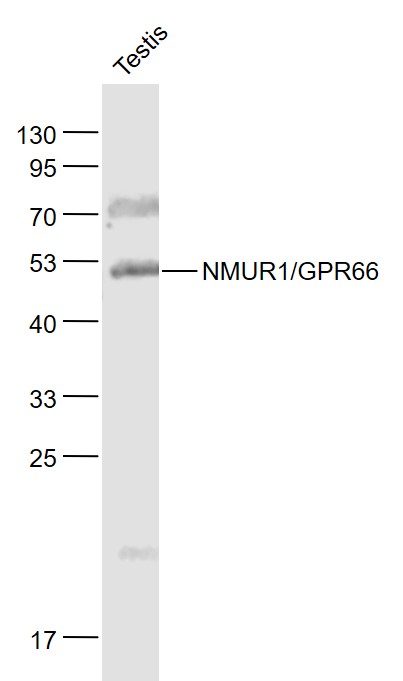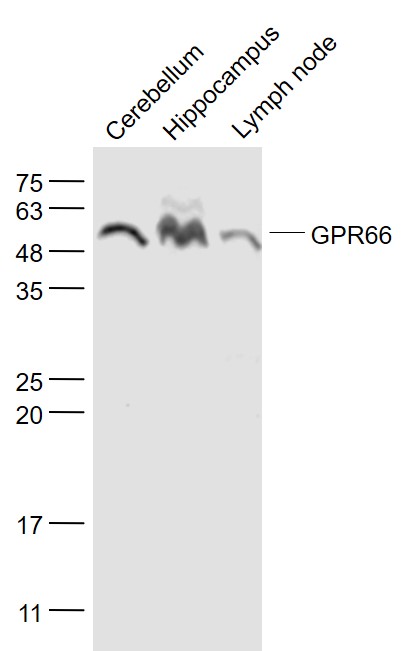NMUR1/GPR66 Rabbit pAb
NMUR1/GPR66 Rabbit pAb
- 产品详情
- 实验流程
- 背景知识
Application
| WB |
|---|---|
| Reactivity | Mouse |
| Host | Rabbit |
| Clonality | Polyclonal |
| Calculated MW | 47 KDa |
| Physical State | Liquid |
| Immunogen | KLH conjugated synthetic peptide derived from mouse NMUR1/GPR66 |
| Epitope Specificity | 1-80/415 |
| Isotype | IgG |
| Purity | affinity purified by Protein A |
| Buffer | 0.01M TBS (pH7.4) with 1% BSA, 0.02% Proclin300 and 50% Glycerol. |
| SUBCELLULAR LOCATION | Cell membrane; Multi-pass membrane protein. |
| SIMILARITY | Belongs to the G-protein coupled receptor 1 family. |
| Important Note | This product as supplied is intended for research use only, not for use in human, therapeutic or diagnostic applications. |
| Background Descriptions | Neuromedin U is a neuropeptide with high activity on smooth muscle. It is widely expressed in gastrointestinal systems and central nervous system (CNS). Peripheral activities of neuromedin U include smooth muscle stimulation, ion transport alterations in the gut and the regulation of local blood flow and adrenocortical function. Neuromedin U receptors 1 and 2 (NMUR1 and NMUR2) are multi-pass membrane proteins that belong to the G-protein coupled receptor 1 family of proteins. Both NMUR1 and NMUR2 act as receptors for the neuromedin U neuropeptide. NMUR1 is detected in peripheral organs, particularly in urogenital and gastrointestinal systems, with highest levels in testis. It’s expression in CNS is low, but the protein has been detected in cerebellum, hippocampus, dorsal root ganglia and spinal cord. NMUR2 is predominantly detected in central nervous system with highest levels detected in medulla oblongata, spinal cord and thalamus. It may also be detected in testis but has low levels of expression in peripheral tissues. |
| Target/Specificity | Expressed in greatest abundance in peripheral organs, particularly in elements of the gastrointestinal and urogenital systems with highest levels in testes. In central nervous system structures express levels are much lower than those seen in peripheral organs. Within the CNS, has been detected in highest abundance in the cerebellum, dorsal root ganglia, hippocampus, and spinal cord. |
|---|---|
| Dilution | WB=1:500-2000 |
| Format | 0.01M TBS(pH7.4) with 1% BSA, 0.09% (W/V) sodium azide and 50% Glyce |
| Storage | Store at -20 °C for one year. Avoid repeated freeze/thaw cycles. When reconstituted in sterile pH 7.4 0.01M PBS or diluent of antibody the antibody is stable for at least two weeks at 2-4 °C. |
Research Areas
For Research Use Only. Not For Use In Diagnostic Procedures.
Application Protocols
Provided below are standard protocols that you may find useful for product applications.
BACKGROUND
This product as supplied is intended for research use only, not for use in human, therapeutic or diagnostic applications.
终于等到您。ABCEPTA(百远生物)抗体产品。
点击下方“我要评价 ”按钮提交您的反馈信息,您的反馈和评价是我们最宝贵的财富之一,
我们将在1-3个工作日内处理您的反馈信息。
如有疑问,联系:0512-88856768 tech-china@abcepta.com.























 癌症的基本特征包括细胞增殖、血管生成、迁移、凋亡逃避机制和细胞永生等。找到癌症发生过程中这些通路的关键标记物和对应的抗体用于检测至关重要。
癌症的基本特征包括细胞增殖、血管生成、迁移、凋亡逃避机制和细胞永生等。找到癌症发生过程中这些通路的关键标记物和对应的抗体用于检测至关重要。 为您推荐一个泛素化位点预测神器——泛素化分析工具,可以为您的蛋白的泛素化位点作出预测和评分。
为您推荐一个泛素化位点预测神器——泛素化分析工具,可以为您的蛋白的泛素化位点作出预测和评分。 细胞自噬受体图形绘图工具为你的蛋白的细胞受体结合位点作出预测和评分,识别结合到自噬通路中的蛋白是非常重要的,便于让我们理解自噬在正常生理、病理过程中的作用,如发育、细胞分化、神经退化性疾病、压力条件下、感染和癌症。
细胞自噬受体图形绘图工具为你的蛋白的细胞受体结合位点作出预测和评分,识别结合到自噬通路中的蛋白是非常重要的,便于让我们理解自噬在正常生理、病理过程中的作用,如发育、细胞分化、神经退化性疾病、压力条件下、感染和癌症。







